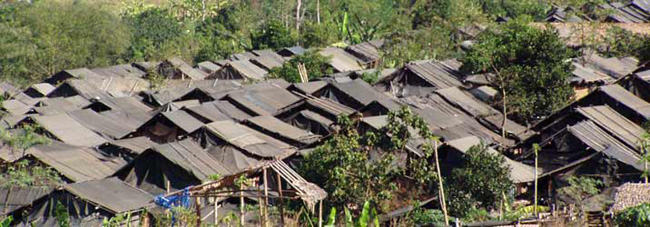This
last year I was able to gain a broader perspective of all seven
of the Karen refugee camps along the Thai-Burma border. ZOA (Dutch
for "South-East Asia"), the major education NGO, invited
me to assist them with their in-service teacher training. I helped
with English teacher training especially in the areas of pronunciation,
phonetics, and learning activities. We visited each of the camps
for only one week, but I was able to help the teachers while learning
a lot about each unique camp.
I will give a brief summary of my experience
focusing on the different aspects of the camps.
First, the ZOA teacher trainers and I visited
Mae La camp, the largest by far, housing 40,000 refugees from
Burma. This camp is the closest to the small city of Mae Sot,
which is the base of operations for most NGO’s and aid workers.
As a result there are many projects in the camp. However, due
to the dense population, Mae La is considered to have some of
the worst living conditions. Situated on the highway, Mae La is
also more vulnerable to the effects of the outside world. Drug
use, especially amphetamines, AIDS, trafficking, and other problems
are more prevalent here than in other camps. It is here that one
really feels the desperation of life as a refugee from Burma.
The next camp I visited was Umpiem Mai,
which is the second largest at around 20,000. It is also located
close to Mae Sot and on the highway. Umpiem is the coldest camp,
with cold season (Nov-Feb) temps dropping to near freezing. After
being moved there, many refugees died from the cold. Now they
make thicker blankets and walls to combat the elements. Umpiem
has made the most of its proximity to Mae Sot by organizing its
education system well. There are good opportunities for education
past high school within the camp.
Nu Po camp is known for the most moderate
climate of all the camps: not too hot and not too cold. Unfortunately,
the camp is quite far from Mae Sot, and the local Thai authorities
are currently making it difficult for NGO’s to visit the
camp. My counterpart from ZOA was unable to go, and I had a difficult
time with the English teachers. Since not many English speakers
visit, the English teachers had a hard time understanding me.
The teachers and I are hoping to be reunited to continue improving
their work.
The next two camps are actually closer to
Bangkok than Mae Sot. The first camp we visited was Tham Hin,
infamous for its plastic roofs. In order to enforce the ideology
of a temporary refugee camp, the Thai authorities prohibit the
refugees from building roofs from the traditional leaves. With
very few trees in the camp, the thick dark roofs trap the heat
and create sweatboxes. The situation is very bad. The tightly
packed houses create more of the “refugee camp” environment
that I have been imagining in Africa. On the brighter side, the
education system in the camp is well organized and very active
and the students are very motivated - for any opportunity to get
out of the camp, I think. I was happy to see that they have Physical
Education (P.E. classes) for the primary level students, which
is nonexistent in other camps.

Tham Hin Refugee Camp
Don Yang camp is closest to Tham Hin, but
over 5 hours by truck, and is the smallest camp at 3,000 residents.
Although much smaller in population than the other camps, the
houses are tightly packed, and the feeling of being imprisoned
is more intense because the Thai Authorities have much more control.
I visited the 9th and 10th grade classes and was surprised to
see six students in each classroom. I was shocked to compare this
with the 60 plus students per class in Mae Ra Moe camp up north.
After leaving the southern reaches of the
camps, the ZOA trainers and I drove up north. We then gathered
the teachers from the two northern Karen camps, Mae La Oon and
Mae Ra Moe, into Mae Ra Moe camp for a two-week training. Mae
Ra Moe is the camp where Angela and I have spent the majority
of our time. I knew the teachers and their classroom situations
well, so it was nice to be with them again for more intensive
English training. I felt like we made good progress because we
were all comfortable around each other.
next
page
|

